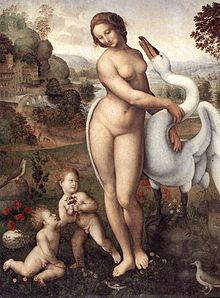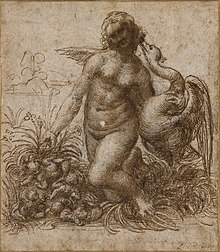Leda with the swan

Leda with the swan was a painting by Leonardo da Vinci that showed the mythological king's daughter Leda with a swan . The painting, of which several versions by Leonardo may have existed, has not survived.
Motif: Leda with the swan
According to Greek legend, Zeus fell in love with Leda and approached her in the shape of a swan and made her pregnant. But Leda's husband Tyndareos also slept with her that night. Leda gave birth to two eggs with four children - Helena , Polydeukes (Latin Pollux), Klytaimnestra and Castor . In some versions it is only Helena hatching from an egg, in others Castor and Polydeukes are born from the same egg.
In the history of art , Leda with the swan has long been a popular erotic motif . Another famous painting of Leda was done by Michelangelo around 1530; but it was also lost.
Two compositions of a Leda with a swan by Leonardo da Vinci have come down to us. The earlier design shows Leda kneeling in the center of the picture, facing the viewer, supporting herself with her right hand, her left leg up. With her left hand, Leda grasps the neck of the swan standing next to her on the right, whereby the traditional sketches differ in that Leda leans her head towards the swan once and then turns it slightly away. In the left foreground, eggshells and four putti can be seen between grass and leaves .
The more recent composition shows Leda standing, her upper body leaning towards the swan standing to the right, which she grips with both hands, her face tilted to the side facing the viewer, her gaze lowered. The swan looks at Leda with his head back. In contrast to the earlier design, the swan is raised so that its head reaches up to Leda's shoulder despite its neck bent backwards. The swan's wings are spread out wide, with its right wing the swan embraces Leda's body and thereby frames him.
The surviving copies each show the image version of the standing Leda, with in the left foreground only two putti with a closed egg, partly four putti with broken eggshells (Helena, Pollux, Kastor and Klytaimnestra). An idealized landscape appears in the background, as it was typically depicted at that time. B. can also be found in the background of the Mona Lisa or Anna self-third .
History of the painting
No original painting has survived; only copies by other artists and drawings by Leonardo's studies and sketches have survived.
Early design: Kneeling Leda
Leonardo's oldest drawings, which can be assigned to a Leda painting as preliminary studies, are dated to 1504. They depict a kneeling female nude. These studies are now kept in the library at Windsor Castle . Two more, probably a little more recent, drawings show Leda facing a swan next to an egg and Leda rising next to two open eggshells. It is unknown whether Leonardo actually translated the idea of the kneeling Leda into a painting.
Leonardo da Vinci: Study for a Kneeling Leda, around 1503–1507, Museum Boijmans Van Beuningen , Rotterdam
Leonardo da Vinci: Study for a Kneeling Leda, Devonshire Collection , Chatsworth House , England
Later design: Standing Leda
Between 1505 and 1507, three other sketches by Leonardo can be dated, which show a standing Leda. Presumably, Leonardo used this to refine his composition for the painting, which was probably made before 1510. The composition of the picture with the standing Leda thus also became the model for the various surviving copies. The original painting is said to have been in Fontainebleau Castle in 1625 , where it was still listed in 1692. Then the trace of the painting is lost.
Copies
Several images are known today that are believed to represent the lost original. All copies deviate more or less from one another in details of the composition.
The only surviving painting that takes Leonardo's drafts of a kneeling Leda is the Kneeling Leda with her children , kept in Kassel today, by the Leonardo pupil Giampietrino .
An early copy of a painting, dated 1510–1513, showing the standing Leda with the swan, the so-called Spiridon-Leda is said to come from the painter Francesco Melzi's studio of Leonard , it is now in the Uffizi in Florence.
Another copy of the painting of Leda standing with the swan, oil on canvas, 112 × 86 cm, made 1510–1515, is now in the Galleria Borghese , which was long ascribed to Leonardo . It bears great resemblance to a red chalk drawing kept in the Louvre , which could also have been created directly after Leonardo's painting.
One of the copies deviates significantly from the original in that the figure of Zeus , who has been transformed into a swan, is replaced by a representation of Cupid standing on a stool. The figure of Leda, reinterpreted as Venus in this version , is depicted in posture and expression very similar to the other copies and sketches that have survived. Unlike there, however, the scene here is not set in the open air or in an idealized landscape, but in an interior space with ornamental floor tiles. This painting, oil on wood in the format 112 × 60 cm, which was created by the Italian painter Giampietrino , who belongs to the circle of Leonardo da Vinci, is dated to 1510–1520 and is now in a private collection in Milan . Another copy made by Giampietrino, closer to the original, is in the C. Gibbs Collection in London.
Leda kneeling with her children , Giampietrino , 1515/20, oil on wood, Gemäldegalerie Alte Meister , Kassel
Leda and the Swan , copy by Cesare da Sesto , 1515–1520. Oil on canvas, Wilton House , England
Leda and the swan , copy attributed to Il Sodoma , around 1510–1515. Tempera on wood, Galleria Borghese , Rome.
Copy attributed to Spiridon Leda , Francesco Melzi , around 1515. Galleria degli Uffizi , Florence
Leda and the Swan , 16th century, oil on wood, Philadelphia Museum of Art , USA
Venus and Cupid by Giampietrino . Oil on canvas, private collection, Milan.
Spiridon Leda
The copy, now known as Spiridon-Leda , from the circle of Leonardo students, was first mentioned at an exhibition in Paris in 1874 as part of the collection of the Marquis de la Rozière. The de la Rozière family bequeathed the painting to the Baron von Roublé, whose widow sold it to Ludovico Spiridon. In 1939 Countess Margherita Gallotti-Spiridon showed "her Leda" at a Leonardo exhibition in Milan. Shortly afterwards, the painting aroused Adolf Hitler's interest, who in 1941 had Prince Philip of Hesse buy it from the Countess and bring it to Germany. The Americans found it there at the end of the war.
In 1948, the Spiridon-Leda was returned to Italy together with the Diskobolos through the mediation of the negotiator Rodolfo Siviero , because the Italian government regarded purchases of Italian works of art during the Nazi era as illegal exports, as Mussolini had disregarded the strict export laws. The Americans, for their part, regarded these works of art as spoils of war, which they awarded and given to the Italian government as a substitute for other destroyed values or objects. The Italian government returned the works of art, insofar as they were " looted property", to their rightful owners.
In the case of the Spiridon-Leda, the Countess Spiridon also tried to get the work back and stated that she had to sell it well below its value. As it turned out later, Countess Spiridon had received a much higher purchase price than initially stated. It could be proven that the Countess had tried to sell the painting herself and that the requested purchase price had been paid in full. The Countess replied to a handwritten letter from Hitler with a " Well-be-thanked-my-dear-Führer " letter. Countess Spiridon was then charged with fraud.
Today the painting is in the possession of the Italian state, it is kept in the Uffizi Gallery in Florence.
Web links
Individual evidence
- ↑ Celine Delavaux: Art You Will Never See . Munich, 2012, pp. 22–25.
- ↑ Guus Houtzager: Illustrated Greek Mythology Encyclopedia . Edition Dörfler im Nebelverlag, Eggolsheim 2006, ISBN 978-3-89555-400-1 , p. 156 (Dutch, original title: Geïlustreerde Griekse mythologie encyclopedie . Translated by Michael Meyer).
- ↑ Celine Delavaux: Art You Will Never See . Munich, 2012, pp. 22–25.
- ↑ Celine Delavaux: Art You Will Never See . Munich, 2012, pp. 22–25.
- ↑ Celine Delavaux: Art You Will Never See . Munich, 2012, pp. 22–25.
- ↑ Jürgen M. Lehmann: On the kneeling Leda with her children by Giampietrino in the Kassel picture gallery . In: Dombrowski, Damian (Ed.): Between the Worlds. Contributions to art history for Jürg Meyer zur Capellen . Weimar 2001, p. 92-105 .
- ↑ Celine Delavaux: Art You Will Never See . Munich, 2012, pp. 22–25.
- ↑ Celine Delavaux: Art You Will Never See . Munich, 2012, pp. 22–25.
- ↑ Celine Delavaux: Art You Will Never See . Munich, 2012, pp. 22-25; Fondazione Federico Zeri ( Memento of the original from January 28, 2015 in the Internet Archive ) Info: The archive link was inserted automatically and has not yet been checked. Please check the original and archive link according to the instructions and then remove this notice. , accessed January 24, 2015.
- ↑ Der Spiegel No. 53, 1949, p. 39 ( online )
- ↑ Der Spiegel No. 53, 1949, p. 39 ( online )
- ^ Database for the Central Collecting Point Munich .










